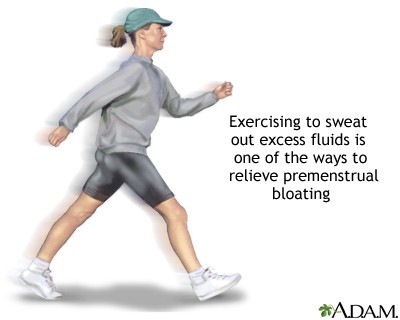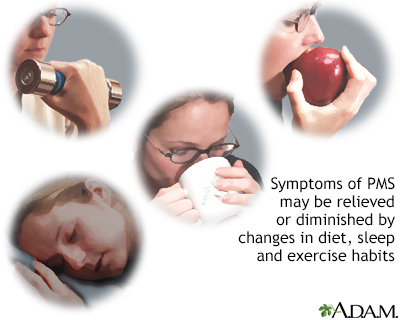Premenstrual syndrome
PMS; Premenstrual dysphoric disorder; PMDD
Premenstrual syndrome (PMS) refers to a wide range of symptoms. The symptoms start during the second half of the menstrual cycle (14 or more days after the first day of your last menstrual period). These usually go away 1 to 2 days after the menstrual period starts.
Images


I Would Like to Learn About:
Causes
The exact cause of PMS is not known. Changes in brain hormone levels may play a role. However, this has not been proven. Women with PMS may also respond differently to these hormones.
PMS may be related to social, cultural, biological, and psychological factors.
Most women experience PMS symptoms during their childbearing years. PMS occurs more often in women:
- Between their late 20s and 40s
- Who have had at least one child
- With a personal or family history of major depression
- With a history of postpartum depression or an affective mood disorder
The symptoms often get worse in late 30s and 40s as menopause approaches.
Symptoms
The most common symptoms of PMS include:
- Bloating or feeling gassy
- Breast tenderness
- Clumsiness
- Constipation or diarrhea
- Food cravings
- Headache
- Less tolerance for noises and lights
Other symptoms include:
- Confusion, trouble concentrating, or forgetfulness
- Fatigue and feeling slow or sluggish
- Feelings of sadness, depression, or hopelessness
- Feelings of tension, anxiety, or edginess
- Irritable, hostile, or aggressive behavior, with outbursts of anger toward self or others
- Loss of sex drive (may increase in some women)
- Mood swings
- Poor judgment
- Poor self-image, feelings of guilt, or increased fears
- Sleep problems (sleeping too much or too little)
Exams and Tests
There are no specific signs or lab tests that can detect PMS. To rule out other possible causes of symptoms, it is important to have a:
- Complete medical history
- Physical exam (including pelvic exam)
A symptom calendar carried out over several months can help women identify the most troublesome symptoms. This also helps in confirming the diagnosis of PMS.
Treatment
Keep a daily diary or log for at least 3 months. Record the:
- Type of symptoms you have
- How severe they are
- How long they last
This record will help you and your health care provider find the best treatment.
A healthy lifestyle is the first step to managing PMS. For many women, lifestyle approaches are often enough to control symptoms. To manage PMS:
- Drink plenty of fluids like water or juice. Do not drink soft drinks, alcohol, or other beverages with caffeine. This will help reduce bloating, fluid retention, and other symptoms.
- Eat frequent, small meals. Do not go more than 3 hours between snacks. Avoid overeating.
- Eat a balanced diet. Include extra whole grains, vegetables, and fruit in your diet. Limit your intake of salt and sugar.
- Your provider may suggest that you take nutritional supplements. Vitamin B6, calcium, and magnesium are commonly used. Tryptophan, which is found in dairy products, may also be helpful.
- Get regular aerobic exercise throughout the month. This helps in reducing the severity of PMS symptoms. Exercise more often and harder during the weeks when you have PMS.
- Try changing your nighttime sleep habits before taking drugs for sleep problems.
Symptoms such as headache, backache, menstrual cramping, and breast tenderness may be treated with:
- Aspirin
- Ibuprofen
- Other NSAIDs
Birth control pills may decrease or increase PMS symptoms.
In severe cases, some medicines used to treat depression may be helpful. Antidepressants known as selective serotonin reuptake inhibitors (SSRIs) are often tried first. These have been shown to be very helpful. You may also want to seek the advice of a counselor or therapist.
Other medicines that you may use include:
- Anti-anxiety drugs for severe anxiety
- Diuretics, which may help with severe fluid retention, which causes bloating, breast tenderness, and weight gain
Outlook (Prognosis)
Most women who are treated for PMS symptoms get good relief.
PMS symptoms may become severe enough to prevent you from functioning normally.
The suicide rate in women with depression is much higher during the second half of the menstrual cycle. Mood disorders need to be diagnosed and treated.
When to Contact a Medical Professional
Contact or make an appointment with your provider if:
- PMS does not go away with self-treatment
- Your symptoms are so severe that they limit your ability to function
- You feel like you want to hurt yourself or others
If you or someone you know is thinking about suicide, call or text 988 or chat 988lifeline.org. You can also call 1-800-273-8255 (1-800-273-TALK). The 988 Suicide and Crisis Lifeline provides free and confidential support 24/7, anytime day or night.
You can also call 911 or the local emergency number or go to the hospital emergency room. DO NOT delay.
If someone you know has attempted suicide, call 911 or the local emergency number right away. DO NOT leave the person alone, even after you have called for help.
Related Information
Premenstrual dysphoric disorderMajor depression
References
Katzinger J, Hudson T. Premenstrual syndrome. In: Pizzorno JE, Murray MT, eds. Textbook of Natural Medicine. 5th ed. Philadelphia, PA: Elsevier; 2021:chap 212.
Mendiratta V, Lentz GM. Primary and secondary dysmenorrhea, premenstrual syndrome, and premenstrual dysphoric disorder: etiology, diagnosis, management. In: Gershenson DM, Lentz GM, Valea FA, Lobo RA, eds. Comprehensive Gynecology. 8th ed. Philadelphia, PA: Elsevier; 2022:chap 35.
Sassarini J, McAllister K. Heavy menstrual bleeding, dysmenorrhea and premenstrual syndrome. In: Magowan B, ed. Clinical Obstetrics and Gynaecology. 5th ed. Elsevier; 2023:chap 7.
BACK TO TOPReview Date: 4/16/2024
Reviewed By: John D. Jacobson, MD, Professor Emeritus, Department of Obstetrics and Gynecology, Loma Linda University School of Medicine, Loma Linda, CA. Also reviewed by David C. Dugdale, MD, Medical Director, Brenda Conaway, Editorial Director, and the A.D.A.M. Editorial team.

Health Content Provider
06/01/2025
|
A.D.A.M., Inc. is accredited by URAC, for Health Content Provider (www.urac.org). URAC's accreditation program is an independent audit to verify that A.D.A.M. follows rigorous standards of quality and accountability. A.D.A.M. is among the first to achieve this important distinction for online health information and services. Learn more about A.D.A.M.'s editorial policy, editorial process and privacy policy. A.D.A.M. is also a founding member of Hi-Ethics. This site complied with the HONcode standard for trustworthy health information from 1995 to 2022, after which HON (Health On the Net, a not-for-profit organization that promoted transparent and reliable health information online) was discontinued. |
The information provided herein should not be used during any medical emergency or for the diagnosis or treatment of any medical condition. A licensed medical professional should be consulted for diagnosis and treatment of any and all medical conditions. Links to other sites are provided for information only -- they do not constitute endorsements of those other sites. © 1997- 2025 A.D.A.M., a business unit of Ebix, Inc. Any duplication or distribution of the information contained herein is strictly prohibited.
